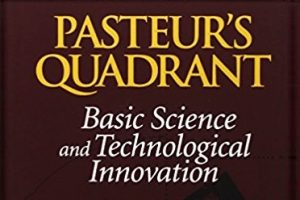I recently came across Donald E. Stokes’ book: “Pasteur’s Quadrant: Basic Science and Technological Innovation”. I had just started a new role in industry as “Science & Technology Lead” and the book turned out to be very helpful. My role was loosely defined, but one key part went along the lines of “get the great scientists we have in our business doing the things that add most value”.
What are our scientists doing?
One of the first things I had to do was to step back and get an understanding of what our great scientists were actually doing.
When I talk about “great scientists” here the individuals I refer to are a group of approximately 50 world leaders in their fields who have chosen to come and work in Pharmaceutical R&D. These are individuals with choices: if they weren’t working with us they could be working in academia, which would be a shame or with our competitors which would be unfortunate!
These are creative people who if given space, time and freedom do great things. The challenge in an R&D intensive business like big pharma is that these things ultimately need to return value if we are to have a sustainable model.
I spent many hours talking and, more importantly, listening to these scientists as they shared with me the range of things they were doing. It was mind-blowing, intimidating even, as the range of scientific specialisms in our department is vast.
Research at AstraZeneca includes:
- understanding of biological systems and cellular transport,
- advanced physics behind the analytical characterization of complex drugs
- chemistry required to synthesis new drugs
- modelling and prediction of drug behaviour in the gut
- engineering challenges associated with developing industrial manufacturing processes that could produce billions of tablets per year.
There was no end of activity. All of it was worthy and challenging.
Some of the work was very clearly applied in its nature, some of it was more fundamental research but any attempt to categorise activities into two simple types: “basic” and “applied” just did not work.
It was at this point that I came across “Pasteur’s Quadrant”.

The book by Donald E.Stokes describes how a simple framework that attempts to describe research as “basic” or “applied” is too simplistic. “Basic Research” for me is about the quest for fundamental understanding or the search for truth whereas “Applied Research” is about consideration of use and application.
Stokes’ book introduces the concept of “use inspired basic research” and presents a simple fourfold table:
A use inspired definition of research
Stokes goes on to describe Bohr’s quest for the fundamental understanding of atomic structure as being all about basic scientific curiosity and the search for truth with little idea about the potential utility of the work. Hence this work by Bohr is categorized as “Pure Basic Research”.
On the other hand Edison’s work in Menlo Park at what Stokes describes as America’s “first industrial research laboratory” was solely focused on the ambition to create commercially profitable electric lighting. Edison’s work is categorized as “Pure Applied Research”. Here the focus is very narrowly targeted on immediate applied goals.
Pasteur’s work always had application in mind yet provided fundamental contributions to science that are key foundations that underpin the whole field of microbiology. Pasteur successfully brought together scientific curiosity and creativity and his work is used as the exemplar of “Use-Inspired Basic Research”.
The fourth quadrant, though blank in the figure, does truly exist and Stokes provides some examples in his book that I will leave you to explore.
Applying the model
Back to the start of this story…with this simple yet powerful framework in mind I made rapid progress with assimilating the work that our “great scientists” were doing. However where the real benefit came was in reflecting the concept of Pasteur’s Quadrant back to the scientists themselves and asking them to consider where their work fitted into Stokes’ model.

There is no right nor wrong in all of this but Pasteur’s Quadrant and the concept of “Use-Inspired Basic Research” is a valuable but simple tool for bringing together the, at times, contradictory concepts of basic and applied research in a complementary and harmonious way and making a little more sense of the true complexity of R&D.
Donald E. Stokes: “Pasteur’s Quadrant: Basic Science and Technological Innovation”.
The Brookings Institute Press. 1997
Dr Joe de Sousa
Director Science & Technology
Global Product Development
AstraZeneca, Macclesfield, UK
*KISS – “Keep It Simple Stupid”

